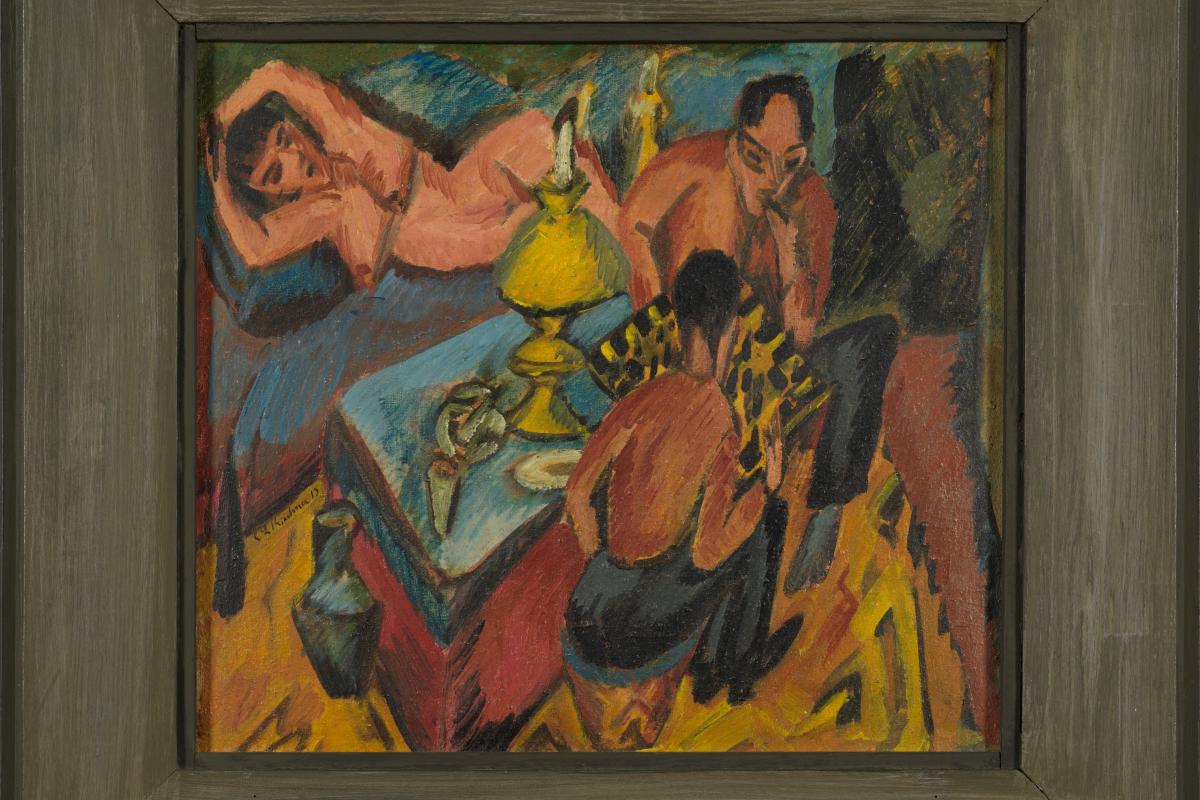A just and fair solution has been found for the restitution claim to the painting Erich Heckel and Otto Mueller Playing Chess by Ernst Ludwig Kirchner at the Brücke-Museum in Berlin. This was announced jointly by the Berlin Senate Department for Culture and Social Cohesion and Anne Webber, Co-Chair of the Commission for Looted Art in Europe, representing the heirs of Dr. Victor Wallerstein. As a result, the 1913 painting will remain at the Brücke-Museum: this has been made possible by funding provided by the Senate Department for Culture and Social Cohesion, the Federal Government Commissioner for Culture and the Media, the Cultural Foundation of the German Federal States and the Ernst von Siemens Art Foundation.
Jewish art historian Victor Wallerstein (born 1878 in Prague, died 1944 in Florence) was an important art connoisseur, art dealer, collector and patron of modern artists. In 1919, Wallerstein and Fritz Goldschmidt founded Galerie Goldschmidt – Wallerstein in Berlin, where the works exhibited included those by artists of the Brücke group. In addition to his work as an art dealer and gallery owner, Wallerstein amassed a private collection that included works by Oskar Kokoschka and Ernst Ludwig Kirchner; he also cultivated contacts and friendships with many of the artists in his collection. As a result of the Nazi dictatorship, the art dealership was forced to close in the summer of 1934 and had to be liquidated in June 1936.
Wallerstein himself was forced to leave Berlin. Seeking refuge in Italy in 1936, he took a small part of his private collection with him, including the painting Erich Heckel and Otto Mueller Playing Chess. In Florence he suffered further persecution and had no way of making a living there. Wallerstein was forced by German and Italian repression to sell works of art, including the Kirchner painting, which he had to sell around 1940. Victor Wallerstein died in a hospital in Florence in July 1944 after being arrested by the SS. The painting found its way to the Brücke-Museum through the art trade in 1973.
In recognition of Victor Wallerstein’s persecution by the Nazi regime and the forced sale of the Kirchner painting, the parties involved agreed in accordance with the Washington Principles that the work would remain at the Brücke-Museum in return for a compensation payment to the community of heirs. Ernst Ludwig Kirchner’s painting is one of the highlights of his creative period in Berlin. It is also the last picture to be painted by a member of the Brücke group before its dissolution. As such, the painting is of particular importance within the Brücke-Museum’s collection.
The Brücke-Museum has dedicated itself intensely to researching the provenance of its collection since 2018, and the exhibition Biographies of Modern Art. Collectors and Their Works from 1 September to 24 November 2024 will provide insights into provenance research at the museum. The focus here is on the biographies of nine former owners of works of art – Jewish personalities who significantly promoted modern art in Germany. Victor Wallerstein will be honoured as one of the key figures – and the painting Erich Heckel and Otto Mueller Playing Chess will be given pride of place. The provenance research was carried out at the Brücke-Museum with the support of the German Lost Art Foundation and the Senate Department for Culture and Social Cohesion.
The German Lost Art Foundation has funded two provenance research projects at the Brücke-Museum in Berlin: Erweiterung des Blickfeldes: Untersuchung von Papierarbeiten des Brücke-Museums [Expanding the perspective. Investigation of works on paper at the Brücke-Museum] and Systematische Untersuchung der Herkunft von Gemälden, Plastiken, Glasbildern und einer Zeichnung aus dem Brücke-Museum [Systematic investigation of the provenance of paintings, sculptures, glass paintings and a drawing at the Brücke-Museum].


